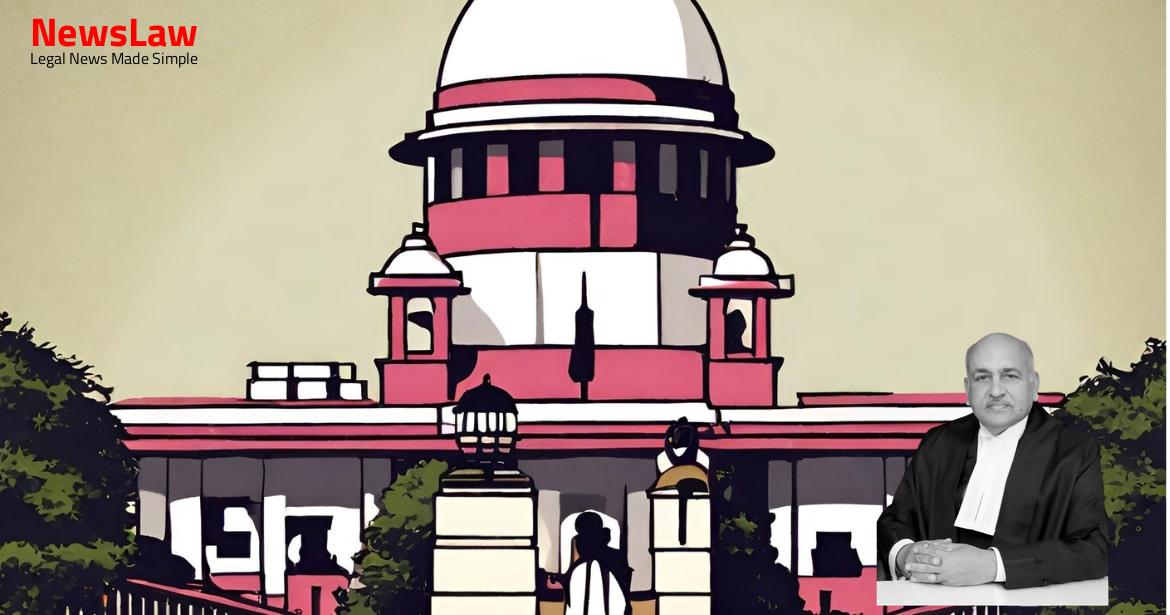In a significant legal case, the Supreme Court of India has delivered a judgement on the implications of stamp duty on agreements to sell. The case pertained to a dispute regarding stamp duty payment for agreements relating to the sale of properties. Find out the key details of the judgement and its implications in the legal landscape.
Facts
- The High Court dismissed the writ petition filed by the appellants.
- The High Court affirmed the trial Court’s order allowing impounding of six documents produced by the appellants.
- The trial Court granted the application of Defendant No.46 for impounding the documents.
- The trial court allowed the application to impound the documents and send them to the Collector of Stamp, Thane for adjudication of stamp duty and penalty.
- Defendants filed their written statements denying the plaint averments.
- An agreement in respect of 2.550 sq. meters of land was executed in favor of Mira Bhayandar Municipal Corporation, requiring no separate stamp duty payment by the appellants.
- Originally, the appellants instituted a suit in Special Civil Suit No.200 of 2008 seeking declaration and injunction.
- Appellants filed a writ petition against the dismissal of their case by the High Court.
- The trial court allowed the impounding of documents which was affirmed by the High Court, misinterpreting the relevant provision.
- Defendant No.46 filed an application under relevant sections to impound six original agreements for sale produced by the appellants, citing lack of proper stamp duty payment due to a clause on possession transfer.
- The documents were dated between 1994 and 2006 and the defendant sought stamp duty payment for conveyance.
Also Read: High Court of Madhya Pradesh Reverses Judgment on Charges against Accused in Assault Case
Issue
- Appellants are being questioned on the liability to pay stamp duty and penalty on agreements to sell executed before the sale deed in their favor for two properties.
- The properties in question are S.No.165/4 measuring 2,550 sq. mtrs. and S.No.208/3 measuring 860 sq. mtrs. along with S.No.208/4 measuring 5,650 sq. mtrs.
- To determine stamp duty, the true intention of the parties from the instrument’s contents and language is vital, regardless of the named instrument.
- The legal rule dictates the real and true meaning of the instrument is decided by the parties’ intentions inferred from the entire instrument’s contents and language.
Also Read: Joint Liability and Common Intention: Supreme Court Verdict
Arguments
- Agreement executed only in terms of Section 4 of the MOF Act.
- A deed of conveyance had to be drawn in terms of Section 11 of the MOF Act.
- Appellants’ counsel argued that the High Court’s conclusion on the construction of the agreement as a ‘conveyance’ was incorrect.
- Appellants’ counsel also argued on the applicability of Explanation I to Article 25 of Schedule I to the Bombay Stamp Act.
- Referring to Section 4 of the Maharashtra Stamp Act, the agreements to sell were ultimately converted into a sale deed in favor of the appellants, which was duly registered after payment of the required stamp duty.
- Due to the registration and stamping of the sale deed, the prior agreements to sell are considered unnecessary to be registered and stamped.
- The argument made by the respondents is that the document executed in terms of Section 4 of the MOF Act should not be considered a conveyance.
- The learned counsel representing the respondents pointed out that the agreements to sell had specific clauses regarding the transfer of physical possession to the purchasers.
- The lower courts were justified in their decision according to the respondents’ counsel.
Also Read: Land Dispute: Decree Quashed by the Supreme Court of India
Analysis
- The High Court upheld the imposition of duty under Explanation I to Article 25 of Schedule I of the Bombay Stamp Act.
- The document in question was deemed to be a conveyance for the purpose of duty payable under the Act due to possession being handed over before the execution of a conveyance.
- The High Court’s decision was based on the absence of a provision for execution of a conveyance in the agreement.
- The Stamp Act’s objective is to levy duty on different instruments, and the duty is on the instrument itself, not just the transaction.
- Subsequent events such as possession handover can impact the character of the instrument as per the terms of the agreement.
- The agreement was considered the principal document on which stamp duty had to be paid per Article 25, despite later conversion into a sale deed.
- Section 32-A of the Bombay Stamp Act applies to agreements deemed as conveyance.
- Stamp duty for agreements covered by the Explanation is levied as if it is a conveyance.
- If parties do not determine the principal instrument, the officer can determine it with the highest duty chargeable among the instruments.
- Section 4(1) states that only the principal instrument in a transaction is chargeable with duty.
- The duty determined for the principal instrument will be the highest duty among all instruments in the same transaction.
- Explanation I of Article 25 in Schedule I pertains to agreements to sell immovable property where possession is transferred before or without the conveyance.
- An agreement for sale is considered a ‘conveyance’ if possession is handed over immediately or agreed to be handed over within a specific time.
- The duty is levied only on the instrument and not on the transaction.
- In the case of Veena Hasmukh Jain v. State of Maharashtra, it was discussed whether an agreement to sell can be deemed a document of conveyance subject to stamp duty.
- The document should have been registered with payment of stamp duty on the agreement for sale initially
- Only the balance on the deed of sale after deduction of the duty already paid ought to have been collected
- Recovery of stamp duty in excess of what is entitled to shall be restricted to the difference in stamp duty and penalty from the date of execution of the agreement for sale
- No case for interference was made out by the appellants, which was affirmed by the High Court
- The second proviso to Article 25 only allows for deduction of stamp duty already paid on the agreement to sale when computing stamp duty payable on the sale deed
- The proviso does not contemplate a situation similar to the case at hand
- The documents impounded cannot be used in evidence until the defect is cured by satisfying the requirements under Section 34
Decision
- The appeal has failed and is dismissed.
- There is no reason to interfere with the orders passed by the lower Courts.
- Any pending application(s) will be closed.
Case Title: SHYAMSUNDAR RADHESHYAM AGRAWAL Vs. PUSHPABAI NILKANTH PATIL (2024 INSC 730)
Case Number: C.A. No.-010804-010804 – 2024



